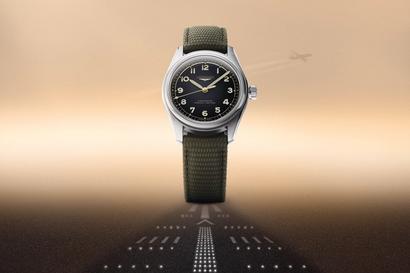

In pictures: 50 years of the Tudor chronograph
From the 1971 'Homeplate' mechanical sports watch, to the 2017 Black Bay Chronograph, we wind back the meticulously ticking history of the Swiss watchmaker
- Words: Jonathan Wells
In 1970, Tudor launched its first chronograph, the Oysterdate. It set the pace for quality Swiss chronographs for the next half century — and, 50 years later, this robust, functional watch is still fondly remembered. Here, we tick back through Tudor’s back catalogue of uniquely designed chronographs.
The Series 7000 ‘Homeplate’ has a sporting background
There’s a reason that Tudor’s first chronograph, the ‘Homeplate’, became associated with mechanical sports watches upon its release in 1970 — and the clue can be found in its nickname. Atop the dial, there’s a luminous pentagonal hour marker on the 7000 series Oysterdate chronograph; one that bears an uncanny resemblance to the home plate on a baseball field.
But it wasn’t just this visual cue that gave the ‘Homeplate’ its sporting association. The first Tudor chronograph also featured a generously proportioned case, a sharp, masculine design and robust mechanical Valjoux 7734 calibre. The model also boasted bezels topped with Plexiglas discs and a 500-unit graduated tachymetric scale, used to calculate average hourly speeds.
The Series 7100 ‘Monte Carlo’ brought blue to Tudor
Launched in 1971, the second generation of Tudor chronographs featured in the brand’s catalogue until 1977. And, in a similar manner to the ‘Homeplate’ above, the Series 7100 once again earned a nickname from its visual cues. This time, it was the roulette wheel-style design of the dial — leading to the ‘Monte Carlo’ moniker.
Under the casino-coloured dial, this chronograph was equipped with the manually wound Valjoux 234; a new, more sophisticated movement with clutch and column wheel. And the colour scheme — from a dusky bullet grey to a piercing orange — also saw the brand’s first use of its now-signature blue.
The Series 9400 Self-winding ‘Big Block’ upped the size
In 1976, Tudor saw a small revolution. The brand’s new Prince Oysterdate watches were the first Tudor chronographs to be equipped with self-winding movements. And, while the case retained the general lines of the previous families, this watch was made thicker to accommodate the size of the self-winding movement. Bulkier and beefier, collectors soon dubbed it the ‘Big Block’.
The movement that necessitated this size increase was the Valjoux calibre 7750. The same diameter as the manually wound Valjoux 234, it featured a cam system chronograph mechanism. And, for the first time, the architecture of a new movement required Tudor to redesign its dial — adding an hour counter and shifting the counter group to the left.
The 79200 Series ‘Sapphire Chronograph’ softened in design
Almost two decades later, in 1995, the introduction of Tudor’s 79200 Series saw the design of the Prince Oysterdate chronograph subtly — yet significantly — updated. The case, which had previously been imposing and sharp, was softened and refined. The silhouette also had its lines curved, and configurations rounded.
These were just several of the notable developments of Tudor’s fourth generation chronograph. A sapphire crystal was introduced — hence this iteration’s nickname — and the case was also rendered in gold and steel editions. There was even a leather strap offered. In fact, the only thing that did stay the same was the movement; the ever-reliable Valjoux calibre 7750.
The 2010 ‘Homeplate’ saw the return of an icon
Ten years ago saw the return of the ‘Homeplate’. Released to mark the 40th anniversary of the first Tudor chronograph, the Heritage Chrono featured a modern design, while still respecting and nodding to the aesthetic elements of the famous 1970 model. The bevelled, polished angles of the horns and iconic ‘homeplates’ also made a reappearance.
Three years later, the Heritage Chrono Blue was also launched — once again nodding to one of Tudor’s famous past designs. This time, it was the turn of the blue-dialled ‘Monte Carlo’ to spin again; ticking on a calibre 2892 with additional chronograph mechanism.
The 2017 Black Back Chronograph tied Tudor together
After a brief departure from the brand’s traditional aesthetics — with 2013’s sporty matt black chronograph, the Fastrider Black Shield — Tudor returned to its signature style in 2017 with the Black Bay Chronograph. Boldly combining the aquatic heritage of the Black Bay family with the chronograph’s timekeeping function, this was arguably Tudor’s largest leap of watchmaking faith.
Boasting a 70-hour power reserve and silicon balance spring, the Manufacture calibre chronograph behind the Heritage Black Bay Chrono presented extraordinary robustness and reliability — and looked every inch the softly designed, delicately dialled, scale-bezelled Tudor chronograph that has characterised the last half century.
Want more of Tudor’s masterful chronographs? Take a look at the Black Bay S&G…
Join the Gentleman’s Journal Clubhouse here.


